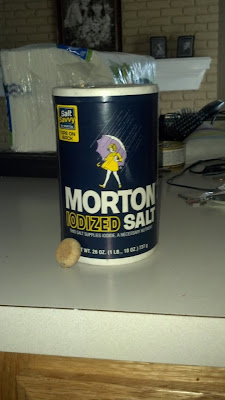Friday, July 27, 2012
Update On Plants! :)
Here are my plants, still alive and healthy. That is the original coleus that we got back in June. If the begonia seems rather small, that's because it is. The original begonia died, as stated in the first email to Mrs. Lawrence. I decided to go and buy a new one and start fresh about 3 weeks ago, so I'm hoping it begins to grow more.
Autotroph
This is a tree in my front yard. It is an example of an autotroph; it makes its own food by photosynthesis which is a chemical reaction where CO2, H20, [inorganic] salts, and sunlight are combined to make the energy. A tree absorbs sunlight through its leaves and combines all of the ingredients within the chloroplatsts of cells.
Animal That Has A Segmented Body/BUG
This here bug is a good example of an animal that has a segmented body. This bug is an Arthopod, classified by its exoskeleton, segmented body and appendages. The segments of the body are split up into the head, thorax, and abdomen. This was easily the most difficult picture I've ever taken; the bug was NOT cooperating in posing next to the cookie.
Anther and Filament Of Stamen
The anther and filament both exsist as part of the reproduction organ of the flower. The filaments are the light green stalks coming from the center of the flower, and the anthers would be the yellow, pollen-covered things connected to the top of the filaments.
Asexual Reproduction
This gorgeous hostess plant is in my front yard. The buds show that the plant is capable of reproduction without fertilization, which is called Asexual Reproduction.
Pollinator/ Dead Bee :)
Again, I apologize for the lack of Cookie of Verification. I took this picture after killing this bee that stung me while I was working. Bees are famously known pollinators, which are organisms that transfer pollen from one plant to another to fertilize. Bees are the leaders in pollination, as they're well adapted to complete the job. Our bee here would be considered an ex-pollinator, perhaps even retired. He shouldn't have stung me.
Hydrophilic
Salt is an example of a Hydrophilic substance. The term hydrophilic is applied to any substance that is "water loving", or basically polar molecules that can form hydrogen bonds with water. Thanks to AP Chemistry, this term actually makes sense to me. Salts as well as sugars are all Hydrophilic.
Connective Tissue
This is a picture of my sister's knee to demonstrate the connective tissue found in the knee. Examples of connective tissue are tendons and ligaments, along with the meniscus. Ligaments connect bones to bones; two major ligaments in the knee are the ACL and the MCL. (Both result in devestating injuries if torn.) The meniscus sits between your femur and tibia and basically acts as a cusion. Finally, tendons connect muscle to bone; examples of tendons in the knee are the patellar tendon, and the ilio-tibial band.
Phloem
This huge branch crashed down in my backyard after a storm. It looks as though it was ripped off the rest of the tree by the wind. With the branch ripped the way it was, it gave me a good look at what the inside of the tree looks like. The lighter colored inner bark is called the Phloem. When it comes to trees, the phloem is the innermost layer of the bark. It mostly deals with the transport materials made during photosynthesis. And as you can see, the Cookie made it in the picture successfully.
Bilateral Symmetry
I apologize that there is no Cookie of Verification, but this picture was taken at Greenfield Village when I went with my family about three weeks ago. I did not have mini cookies on me at the time... lesson learned.
Anyway, this beautiful butterfly is a perfect example of Bilateral Symmetry. In bilateral symmetry, one plane (called the sagittal plane) divides an organism into mirror-image halves. From the markings on the wings, they seem to exhibit the mirror-image look.
Parasitism
This is a picture of a caterpillar resting on a branch (and the This-Is-An-Original-Picture Cookie of Verification, or COV ;).) The branch will represent a full-size tree in this case. This picture represents PARASITISM, which is a non mutual relationship between organisms of different species where one organism (the parasite) benefits at the expense of the other (the host). In this case, the caterpillar is a parasite who feeds off the tree, acting as our host, with no benefit to the tree.
Subscribe to:
Comments (Atom)










